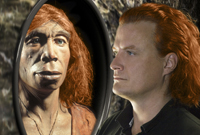A trawl through the emerging neanderthal genome has revealed that our hominid relatives, the Neanderthals, probably had red-heads amongst their numbers.
 Writing in this week's Science, Carles Lalueza-Fox from the University of Barcelona, together with an international team of collaborators, successfully sequenced the melanocortin 1 receptor gene (mc1r) from two Neanderthal specimens, one Spanish and one Italian. The mc1r gene controls how cells respond to a hormone called MSH - melanocyte stimulating hormone. It's known that amongst modern humans variations in this gene affect the amounts of the two pigment moelcules eumelanin and phaeomelanin that are made in the skin, with red heads and pale skinned individuals making proportionally less eumelanin. When the researchers used the polymerase chain reaction to copy part of this gene from their Neanderthal remains they found a variant of the gene never before seen amongst modern humans. To find out what effect it might have they added the gene to cells grown in the dish and then treated the cells with MSH. The cells behaved almost identically to cells containing the mc1r gene from modern pale-skinned humans, suggesting that the Neanderthals who originally carried this gene variant would also have had a pale complexion and red hair.
Writing in this week's Science, Carles Lalueza-Fox from the University of Barcelona, together with an international team of collaborators, successfully sequenced the melanocortin 1 receptor gene (mc1r) from two Neanderthal specimens, one Spanish and one Italian. The mc1r gene controls how cells respond to a hormone called MSH - melanocyte stimulating hormone. It's known that amongst modern humans variations in this gene affect the amounts of the two pigment moelcules eumelanin and phaeomelanin that are made in the skin, with red heads and pale skinned individuals making proportionally less eumelanin. When the researchers used the polymerase chain reaction to copy part of this gene from their Neanderthal remains they found a variant of the gene never before seen amongst modern humans. To find out what effect it might have they added the gene to cells grown in the dish and then treated the cells with MSH. The cells behaved almost identically to cells containing the mc1r gene from modern pale-skinned humans, suggesting that the Neanderthals who originally carried this gene variant would also have had a pale complexion and red hair.
The team estimate that, on the basis of their findings, at least 1% of the Neanderthal population probably looked like this. The result is also interesting because it adds weight to the idea that pale skin suited populations living north of the Equator, and also seems to disprove the claim that Neanderthals disappeared because they interbred with modern humans. If this were true then we should see this red-headed Neanderthal mc1r variant cropping up in modern humans, but so far that hasn't happened.










Comments
Add a comment